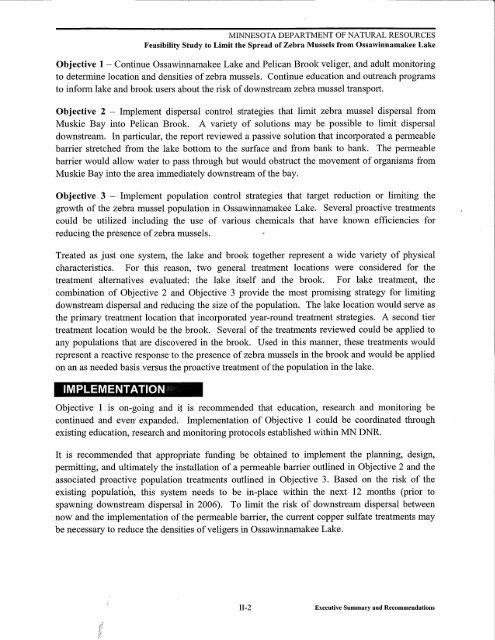Consultant's Report - Minnesota State Legislature
Consultant's Report - Minnesota State Legislature
Consultant's Report - Minnesota State Legislature
Create successful ePaper yourself
Turn your PDF publications into a flip-book with our unique Google optimized e-Paper software.
MINNESOTA DEPARTMENT OF NATURAL RESOURCES<br />
Feasibility Study to Limit the Spread ofZebra Mussels from Ossawinnamakee Lake<br />
Objective 1 - Continue Ossawinnamakee Lake and Pelican Brook veliger, and adult monitoring<br />
to detennine location and densities ofzebra mussels. Continue education and outreach programs<br />
to infOlID lake and brook users about the risk ofdownstream zebra mussel transport.<br />
Objective 2 - Implement dispersal control strategies that limit zebra mussel dispersal from<br />
Muskie Bay into Pelican Brook. A variety of solutions may be possible to limit dispersal<br />
downstream. In particular, the report reviewed a passive solution that incorporated a penneable<br />
barrier stretched from the lake bottom to the surface and from bank to ban1e The penneable<br />
barrier would allow water to pass through but would obstruct the movement of organisms from<br />
Muskie Bay into the area immediately downstream ofthe bay.<br />
Objective 3 - Implement population control strategies that target reduction or limiting the<br />
growth of the zebra mussel population in Ossawinnamakee Lake. Several proactive treatments<br />
could be utilized including the use of various chemicals that have known efficiencies for<br />
reducing the presence ofzebra mussels. '<br />
Treated as just one system, the lake and brook together represent a wide variety of physical<br />
characteristics. For this reason, two general treatment locations were considered for the<br />
treatment alternatives evaluated: the lake itself and the brook. For lake treatment, the<br />
combination of Objective 2 and Objective 3 provide the most promising strategy for limiting<br />
downstream dispersal and reducing the size of the population. The lake location would serve as<br />
the primary treatment location that incorporated year-round treatment strategies. A second tier<br />
treatment location would be the brook. Several of the treatments reviewed could be applied to<br />
any populations that are discovered in the brook. Used in this manner, these treatments would<br />
represent a reactive response to the presence ofzebra mussels in the brook and would be applied<br />
on an as needed basis versus the proactive treatment ofthe population in the lake.<br />
IMPLEMENTATION<br />
Objective 1 is on-going and it is recommended that education, research and monitoring be<br />
continued and evett expanded. Implementation of Objective 1 could be coordinated through<br />
existing education, research and monitoring protocols established within MN DNR.<br />
It is recommended that appropriate funding be obtained to implement the planning, design,<br />
pennitting, and ultimately the installation of a penneable barrier outlined in Objective 2 and the<br />
associated proactive population treatments outlined in Objective 3. Based on the risk of the<br />
existing population, this system needs to be in-place within the next 12 months (prior to<br />
spawning downstream dispersal in 2006). To limit the risk of downstream dispersal between<br />
now and the implementation ofthe penneable barrier, the current copper sulfate treatments may<br />
be necessary to reduce the densities ofveligers in Ossawinnamakee Lake.<br />
11-2 Executive Summary and Recommendations
















